Is your garden feeling a little... flat? Do your veggies seem content to just lounge around, while you are thinking ‘something has to happen here?’
Well, it’s time to give your veggies a nudge (or a lift)! Let’s take your gardening game to new heights—literally—by embracing the brilliant, practical world of vertical gardening with trellises and netting. Not only will your plants be reaching for the heavens, you’ll save space, boost yields, impress the neighbors, and will be able to give yourself a hearty pat on the back.
So, grab your gardening gloves, and let’s get climbing!
Your Vertical Veggie Adventure Begins
Think of vertical gardening as a playground for your plants—a place where peas swing, beans climb, and tomatoes perform acrobatic feats (with a little help, of course). By providing trellises and netting, you’re giving your veggies the opportunity to explore the vertical dimension, making the most of your garden space and keeping them healthy and happy.
Why Go Vertical?
- Space Magic: Turn that tiny patch of soil into a towering veggie paradise.
- Fresh Air: Elevate your plants for better airflow and fewer fungal funks.
- Sunshine Galore: Let every leaf bask in the glow of the sun.
- Easy Pickings: Harvesting becomes a breeze when everything’s at eye level.
- Eye Candy: Vertical gardens can be real show-stoppers!
Meet the Ascending Performers
Not every veggie is eager to leave the ground, but some just can’t wait to climb. Let me introduce you to the super star climbers, explain how much elbow room they’ll need, and how you can best support their skyward ambitions.
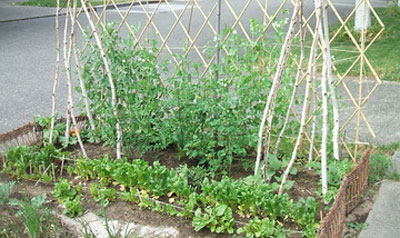
- Peas: Vertical Virtuosos
Peas are the natural gymnasts of the garden world. Give them a trellis, netting, or even a teepee made of bamboo poles, and they’ll put on a spectacular show!
- Space Basics: Plant pea seeds or pea starter plants about 2 inches apart, with rows (or trellises) spaced at least 18-24 inches apart to allow for airflow and easy access.
- Support Plans: Peas need support sturdy enough for their thrill-seeking vines. I suggest at least 6-feet.
- Climbing Gear: Chicken wire or nylon netting stretched between posts is perfect for those tiny tendrils.
- Perks: Peas growing off the ground stay clean and are much easier to pick (no more bending!).
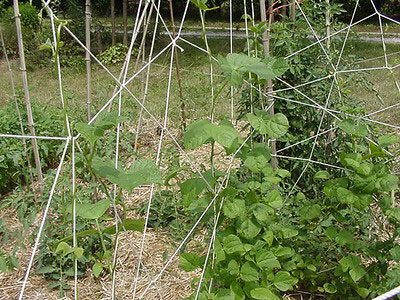
- Pole Beans: Towering Titans
Pole beans aren’t just beans—they’re beanstalks (minus the giants, of course). These vigorous climbers can reach up to 8 feet high, so they need strong support to match their grandiose ambitions.
- Space Needed: Plant bean seeds or starter plants about 4-6 inches apart at the base of the support, with your supports spaced about 3 feet apart to give each plant room to grow and to ensure your easy access.
- Support Options: Sturdy trellises, teepee structures, or tall stakes connected with twine or netting will provide these gymnasts with the support they need to achieve greatness.
- Garden Glamour: Growing your bean plants on a cattle panel arch will add a touch of whimsy and makes your garden look more captivating.
- Harvest Heroics: With beans hanging down freely, picking is a snap (pun intended)!
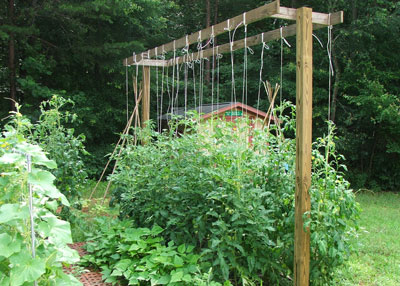
- Tomatoes: High-Flying Heirlooms & Heroes
Indeterminate tomatoes are the embodiment of overachievement—they just keep growing and growing and…. They need a little help to maintain their equilibrium as they reach for the sky.
- Space Fundamentals: Space tomato plants about 18-24 inches apart when grown vertically to ensure good airflow and access for pruning and harvesting.
- Support Strategies: Tall stakes (6 feet or more), extra-large tomato cages, or a string trellis system will provide the support that is necessary for vertical veggie growth.
- Tying the Knot: Use soft twine or tomato clips to gently secure them, preventing the dreaded tomato tumble.
**Cherry Tomatoes: These little guys think they’re in a race to the top. Supports of 8-10 feet may be needed! Space them similarly to their larger cousins, about 18-24 inches apart.

- Cucumbers: Cool Climbers
Cucumbers are like the rambunctious athletes in school—they effortlessly grab on and climb like monkeys.
- Space Essentials: Plant cucumber seeds or seedlings about 12 inches apart at the base of your trellis. If planting multiple trellises, space them about 3-4 feet apart.
- Support Solutions: Trellises, livestock panels, or sturdy netting stretched between posts (5-6 feet tall) are the ideal playground equipment for their climbing enjoyment.
- A-Frame Fun: An A-frame trellis not only supports your cucumber plants, but also creates a shady cucumber cave—fun for kids and adults alike!
- Straight Talk: Vertical, unencumbered growth helps produce straighter cucumbers (no more curly cucumbers hiding in the dirt)!
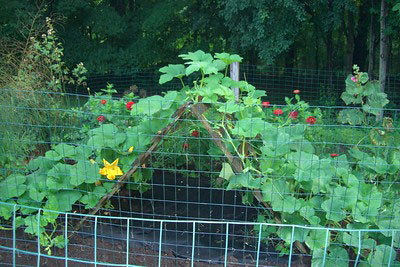
- Squash (Vining Varieties): Mighty Mountaineers
Vining squash are always ready to take on a vertical challenge, though these burly veggies need a strong hand (or trellis) to guide them.
- Space Prerequisites: Plant vining squash about 18-24 inches apart, providing ample space between trellises—about 4-6 feet—to accommodate their large leaves.
- Vigorous Support: Very strong trellises or sturdy cattle panels are needed to handle this veggie’s heft.
- Sling It: Create hammocks from old t-shirts or netting to cradle those weighty squash as they grow.
- Visual Charm: An arch made from livestock panels will turn your ever-growing squash plants into a squash cathedral.
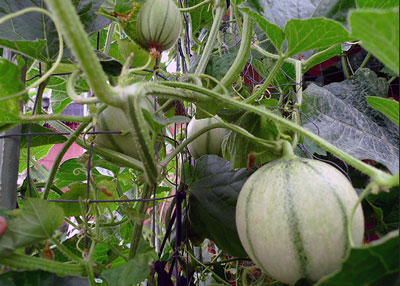
- Melons (Small Varieties): Sweet Climbers
Who says melons can’t climb? Smaller varieties of watermelons are even up for the challenge with suitable support.
- Space Musts: Plant melon seeds or starter plants about 18 inches apart. You should space trellises about 4-6 feet apart due to their sprawling nature.
- Support Strength: A reinforced trellis or arch is a must to bear the weight of your melons.
- Melon Hammocks: Use mesh bags or pantyhose (yes, really!) to make slings that support the fruit while ensuring good air circulation.
- Benefits: Keeps melons off of the ground, away from pests, and looking fabulous.
Crafting Your Sky-High Structures
Ready to build your vertical veggie utopia? Here’s how to create vertical vegetable supports that are both functional and fun.
Materials You’ll Need
- Supports: Think wooden stakes, metal poles, bamboo canes, or even cattle panels (for the ambitious).
- Connectors: Twine, zip ties, or relatively heavy wire to hold everything together.
- Climbing Surfaces: Nylon netting, chicken wire, or mesh are an absolute necessity for those tendrils to grab onto.
- Tools of the Trade: Hammer, nails, screws, and a drill for the DIY enthusiast…or perfectionist...you know who you are!
Building Basics
- Plot Your Plan: Decide who climbs where—peas over here, beans over there. Draw a picture if that will help with your planning, considering your spacing requirements.
- Sunshine Please: Most vegetables require at least 6-8 hours of sunlight daily, though some can tolerate partial shade and may need only 4-6 hours.
- Set the Stage: Firmly plant your supports into the ground (no wobbly trellises, please). If you want this part to be one and done, use concrete!
- Connect the Dots: Attach crosspieces or stretch netting between supports.
- Test the Strength: Give it a good shake—better it falls now than when laden with veggies!
- Guide the Way: Loosely tie your plants to the supports as they grow (they may need some guidance). Be sure to leave enough room within the tie for the stems to grow.
Professional Tips for Vertical Victory
Space Smartly
Even vertical climbers need room to stretch their roots. Be mindful of the spacing recommendations for each plant to avoid overcrowding and to promote healthy growth, while also allowing you easy access to harvest.
Tie the Knot Gently
Use soft ties—like garden tape or cloth strips—to avoid bruising those tender stems. Your plants will thank you, rewarding you with an abundance of delicious veggies.
Tend to Your Vegetable Garden
Just like planting horizontally, vertical vegetable gardens need love too…just not at much. It is definitely easier to keep your veggies happy when allowing them to reach for the stars.
- Prune Party: Trim excess leaves to keep things airy and to ensure the life-giving sunshine shines where it needs to.
- Pest Patrol: Check for sneaky bugs trying to hitch a ride upwards. It is true that vertical vegetable growth inhibits those soil-borne pests that can devastate a garden, but other pests may like the view from up there.
- Structural Integrity: Ensure your supports remain strong as your plants grow (no one wants a mid-season collapse).
Support the Heavyweights
For those veggies that had one too many (looking at you, melons and squash), create slings to take the load off of the vines. A little-known fact: cantaloupes and watermelons are actually considered veggies, in the same family as squash and gourds; we just use them as a fruit due to their being sweet.
Hydration Station
Vertical gardens can get thirsty. Always water at the base to keep roots happy and to prevent foliar diseases; consider mulching to retain moisture and a drip hose on a timer to make watering effortless.
The Perks of Growing Up
- Cleaner Crops: No more dirt-covered veggies, yellow spots from laying on the ground (or surprise bites from ground critters).
- Back-Friendly: Harvesting without hunching—your spine will thank you. In fact, you will thank you!
- Garden Eye Candy: Vertical elements add drama and beauty to your space.
- Microclimate Magic: Create shade for other plants and a haven for beneficial insects and pollinators.
The Sky’s the Limit!
Vertical gardening with trellises and netting is ultimately very practical—AND a blast! You’ll marvel as your peas reach for the clouds and your cucumbers dangle like ornaments. You‘ll say a silent (or not so silent) thank you every time you harvest. The bonus? You’ll impress your friends, family, and social media followers with your garden’s vertical flair and bountiful harvest.
So why keep your veggies grounded when they can soar? Embrace this skyward journey; watch your garden (and your harvest) reach new heights!
































































































































































































































































































































































































































































































































































































































































